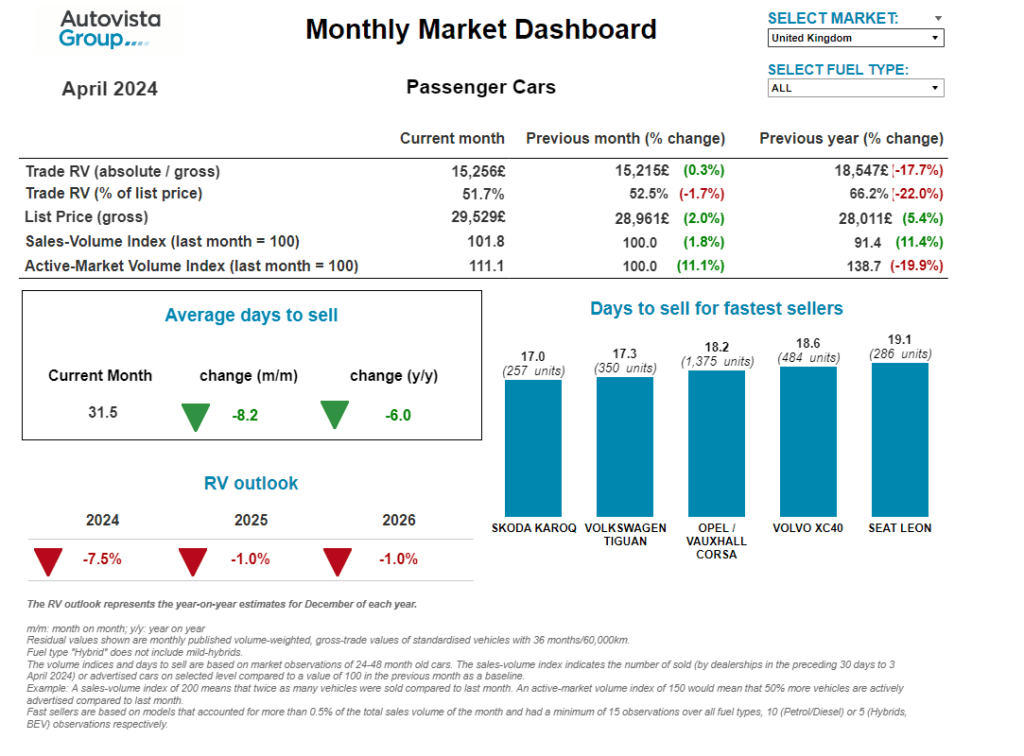Battery-electric vehicle (BEV) residual values (RVs) continued to suffer across Europe’s major used-car markets in April. Autovista Group (part of J.D. Power) experts examine the data with Autovista24 editor Tom Geggus.
Three-year-old BEVs at 60,000km continue to see low RVs presented as a percentage of list price (%RV). Across Austria, Germany, Italy, Spain, Switzerland and the UK, the technology’s value retention is far behind that of the other major powertrains.
Austria saw BEVs achieve one of the highest %RV levels at 45.1%. This was still below the overall market average of 51.8% and even further behind full hybrids (HEVs) which retained 55.8% of their original list price. In Germany, BEV %RVs sat at 40.1%, once again trailing HEVs (54.3%). The all-electric powertrain was also behind the powertrain average of 50.2% in the country.
BEVs saw the lowest %RV result in Italy, with such models only retaining 35.9% of their original list price value after three years and 60,000km. This was far below diesel as the leading powertrain at 57.1%, and the market average of 53.1%.
At 49.4%, BEV %RVs appeared to perform better in Spain. However, there was still a considerable gap between this result and HEVs, which led the market with a value retention rate of 64.7%. The wider market saw %RVs reach 59.3%.
HEVs also led value-retention rates in Switzerland at 51.6%, with the overall market reaching 47.7%. This left BEVs behind, holding onto only 44% of their original list price. Meanwhile, BEVs reached a %RV of only 37.1%, while the powertrain average sat at 51.7% and HEVs led the way with 54.2%.

The interactive monthly market dashboard examines passenger-car data by fuel type, for Austria, Germany, Italy, Spain, Switzerland, and the UK. It includes a breakdown of key performance indicators, including RVs, new-car list prices, selling days, sales volume and active-market volume indices.
Electric values suffer
Many European used-car markets saw BEV %RVs fall both month on month and year on year. The reasons behind these falling all-electric values are numerous. First of all, the rapidly advancing technology in new BEVs is aging older models significantly, making their ranges and capabilities look dated.
Secondly, companies like Hertz are reportedly seeing lower demand and higher repair costs for electric vehicles (EVs). This led to large-scale de-fleeting, with the company already planning to sell 30,000 plug-in units this year.
This will not only increase supply into the used market but will dent public confidence in EVs. This could lead to the popularity of stepping-stone technologies like HEVs and plug-in hybrids (PHEVs) increasing. These vehicles benefit from green credentials alongside the security of an internal-combustion engine (ICE).
With incentives ending across many European new-car markets last year, carmakers are also under increasing pressure to adjust BEV prices. With more affordable models arriving from China, a price war will only serve to damage used BEV values as the apparent value of existing models drops.
Stock moving quickly in UK
For the second consecutive month, the average number of days it took a dealer to sell a used car fell by over a week. At just 31.5 days, this is the lowest average seen since the extraordinary results of 2021, when strong demand led values to rise significantly.
‘Dealers have clearly been able to move stock quickly,’ commented Jayson Whittington, Glass’s (part of J.D. Power) chief editor, cars and leisure vehicles. ‘While the sales-volume index reflects a rise in activity, up 1.8% on last month, it is perhaps surprising that there has not been a greater spike in sales.’
The active-market volume index shows an 11.1% month-on-month increase in the number of cars advertised by dealers. So, there does not seem to be a shortage of stock, but perhaps the most in-demand stock is not currently plentiful. Therefore, when these models do hit forecourts they sell very quickly, affecting the overall average days-to-sell figures.
The wholesale market remained reasonably steady in late March and throughout the first half of April. Auction conversion rates have been satisfactory but have now begun to decline. Buyers appear more cautious of late, with some limited to only cherry-picking the best stock.
Cars with condition issues have been particularly difficult to sell, with rising costs of repair and delays in bodyshops deterring dealers. Hammer prices have been described as ‘seasonal’ by some commentators.
The average value of a three-year-old car, presented as a percentage of cost-new price, fell from 52.5% in March to 51.7% in April. Although this is 14.5 percentage points lower than April last year, it remains 4.4 percentage points higher than the equivalent value three years ago.
This content is brought to you by Autovista24.

 Close
Close